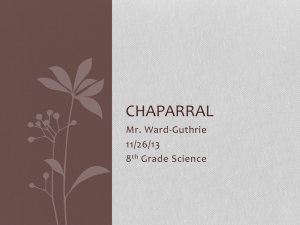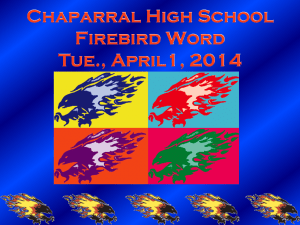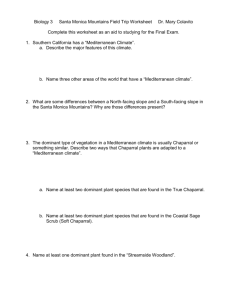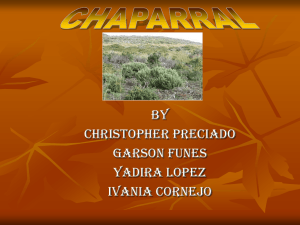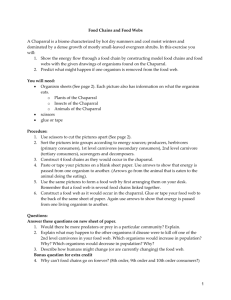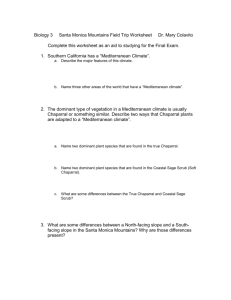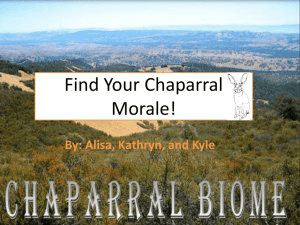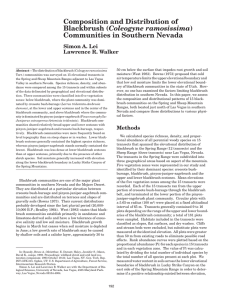Creosotebush, Blackbrush, and Interior Chaparral Shrublands Chapter 6 Creosotebush Scrub
advertisement
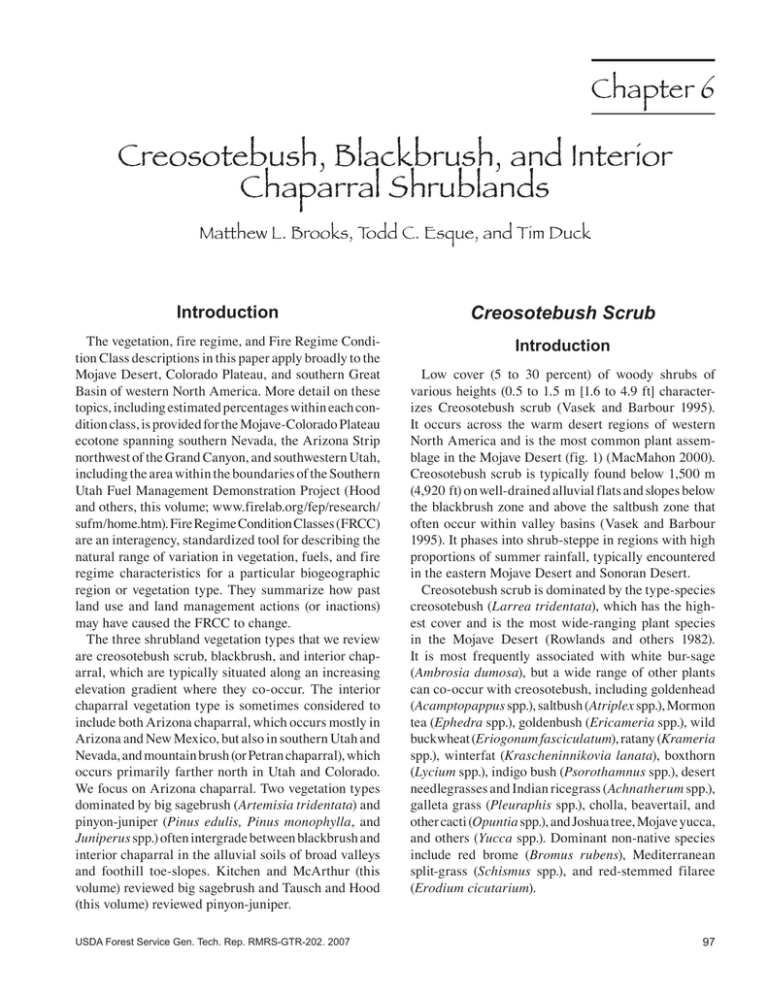
Chapter 6 Creosotebush, Blackbrush, and Interior Chaparral Shrublands Matthew L. Brooks, Todd C. Esque, and Tim Duck Introduction The vegetation, fire regime, and Fire Regime Condition Class descriptions in this paper apply broadly to the Mojave Desert, Colorado Plateau, and southern Great Basin of western North America. More detail on these topics, including estimated percentages within each condition class, is provided for the Mojave-Colorado Plateau ecotone spanning southern Nevada, the Arizona Strip northwest of the Grand Canyon, and southwestern Utah, including the area within the boundaries of the Southern Utah Fuel Management Demonstration Project (Hood and others, this volume; www.firelab.org/fep/research/ sufm/home.htm). Fire Regime Condition Classes (FRCC) are an interagency, standardized tool for describing the natural range of variation in vegetation, fuels, and fire regime characteristics for a particular biogeographic region or vegetation type. They summarize how past land use and land management actions (or inactions) may have caused the FRCC to change. The three shrubland vegetation types that we review are creosotebush scrub, blackbrush, and interior chaparral, which are typically situated along an increasing elevation gradient where they co-occur. The interior chaparral vegetation type is sometimes considered to include both Arizona chaparral, which occurs mostly in Arizona and New Mexico, but also in southern Utah and Nevada, and mountain brush (or Petran chaparral), which occurs primarily farther north in Utah and Colorado. We focus on Arizona chaparral. Two vegetation types dominated by big sagebrush (Artemisia tridentata) and pinyon-juniper (Pinus edulis, Pinus monophylla, and Juniperus spp.) often intergrade between blackbrush and interior chaparral in the alluvial soils of broad valleys and foothill toe-slopes. Kitchen and McArthur (this volume) reviewed big sagebrush and Tausch and Hood (this volume) reviewed pinyon-juniper. USDA Forest Service Gen. Tech. Rep. RMRS-GTR-202. 2007 Creosotebush Scrub Introduction Low cover (5 to 30 percent) of woody shrubs of ­various heights (0.5 to 1.5 m [1.6 to 4.9 ft] characterizes Creosotebush scrub (Vasek and Barbour 1995). It occurs across the warm desert regions of western North America and is the most common plant assemblage in the Mojave Desert (fig. 1) (MacMahon 2000). Creosotebush scrub is typically found below 1,500 m (4,920 ft) on well-drained alluvial flats and slopes below the blackbrush zone and above the saltbush zone that often occur within valley basins (Vasek and Barbour 1995). It phases into shrub-steppe in regions with high proportions of summer rainfall, typically encountered in the eastern Mojave Desert and Sonoran Desert. Creosotebush scrub is dominated by the type-­species creosotebush (Larrea tridentata), which has the highest cover and is the most wide-ranging plant species in the Mojave Desert (Rowlands and others 1982). It is most frequently associated with white bur-sage (Ambrosia dumosa), but a wide range of other plants can co-occur with creosotebush, including goldenhead (Acamptopappus spp.), saltbush (Atriplex spp.), Mormon tea (Ephedra spp.), goldenbush (Ericameria spp.), wild buckwheat (Eriogonum fasciculatum), ratany (Krameria spp.), winterfat (Krascheninnikovia lanata), boxthorn (Lycium spp.), indigo bush (Psorothamnus spp.), desert needlegrasses and Indian ricegrass (Achnatherum spp.), galleta grass (Pleuraphis spp.), cholla, beavertail, and other cacti (Opuntia spp.), and Joshua tree, Mojave yucca, and others (Yucca spp.). Dominant non-native species include red brome (Bromus rubens), Mediterranean split-grass (Schismus spp.), and red-stemmed filaree (Erodium cicutarium). 97 Chapter 6—Creosotebush, Blackbrush, and Interior Chaparral Shrublands Figure 1—Creosotebush (Larrea tridentata) scrub in the Mojave Desert. Within the Mojave-Colorado plateau ecotone, creosotebush scrub reaches its northeast limit in southwestern Utah near the entrance to Zion National Park and follows the Virgin River Valley to Lake Mead in Nevada. It occurs in most of this river drainage below 1,250 m (4,100 ft) elevation. Its distribution broadens below the Hurricane Fault in Utah, spreading northward as far as Browse along Interstate 15 and then following the base of the red cliffs throughout the Dixie Valley north of Washington, St. George, and Gunlock, Utah. There is a large stand south of St. George in the Blake Lambing Grounds and other stands are located throughout the Virgin River Gorge. Below the Gorge, the distribution spreads from the foot of the Beaver Dam Mountains and around Utah Hill, up the Beaver Dam Wash northward to Jackson Wash almost meeting with the creosotebush scrub community west of the town of Gunlock. From Littlefield, Arizona, there is continuous creosotebush scrub all the way to Lake Mead and Las Vegas, Nevada, with only minor interruptions in very rocky areas. Creosotebush and associated plants provide much of the microhabitat diversity and vertical habitat structure in the Mojave Desert. Branches provide perches and nesting opportunities for songbirds, while desert tortoises 98 (Gopherus agassizii) and a variety of rodents incorporate the root structure into their burrows. Shrubs also provide concealment and escape cover from predators and shade from the sun. Many Mojave Desert shrubs are not fire-tolerant ­because their drought-adaptive features (thin bark, shallow root system, small leaves) and high dead-to-live woody material ratio make them vulnerable to fire. Some species, including creosotebush, can resprout after burning (fig. 2); however, survival rates decline significantly if more than 10 percent of their aboveground biomass is consumed by fire (Brooks and Minnich 2006). ­Native plants are generally slow to re-establish after fire and recurrent fire may prevent their re-establishment (Brooks and Minnich 2006; Brown and Minnich 1986; O’Leary and Minnich 1981). The loss of native plants can be followed by increased dominance of non-native annual grasses. The post-fire vegetation has typically lower species diversity and plant structural diversity than the native community, which can negatively ­affect the desert tortoise (Brooks and Esque 2002; Esque and others 2003) and other desert wildlife. Repeated burning in creosotebush scrub can lead to significant decreases in plant species richness with each subsequent fire (M. Brooks, unpublished data). USDA Forest Service Gen. Tech. Rep. RMRS-GTR-202. 2007 Chapter 6—Creosotebush, Blackbrush, and Interior Chaparral Shrublands Figure 2—Creosotebush (Larrea tridentata) resprouting 1 year after a low intensity fire. Historical Conditions We do not know the pre-settlement fire conditions in warm desert plant communities such as creosotebush scrub because the typical analytical methods, such as dendrochronology and evaluating charcoal deposits in lakes, are not possible where the requisite trees and lakes are not present (Brooks and Minnich 2006; Esque and Schwalbe 2002). It is generally thought that fires in creosotebush scrub were an infrequent event in presettlement desert habitats because fine fuels from winter annual plants were probably sparse, only occurring in large amounts after exceptionally wet winters (Brooks and Esque 2002; Brooks and Minnich 2006; Brown and Minnich 1986; Esque and Schwalbe 2002; Humphrey 1974; O’Leary and Minnich 1981; Salo 2003). Fires were probably more frequent in adjacent shrub-steppe areas where perennial grasses provided additional fuel continuity to carry fire. It appears that wildfire was not historically a dominating influence in creosotebush scrub landscapes, except possibly where it intergraded with shrub-steppe. Creosotebush scrub fuels are comprised primarily of woody shrubs, but it is the fine fuels from annuals and perennial grasses that facilitate the ignition and spread of fires. Native annual plants usually break down rapidly during the summer after they are produced and do not USDA Forest Service Gen. Tech. Rep. RMRS-GTR-202. 2007 create a long-lived fuelbed (Brooks 1999a). As a result, the historical annual plant fuelbed, prior to the invasion by non-native species, was probably transient, only lasting for one summer fire season after winters of exceptional high rainfall. Perennial grasses may have been more prevalent in creosotebush scrub before the introduction of livestock grazing, providing another source of fine fuels that could additionally have helped carry fire in the past (Brooks and Minnich 2006). However, stands of perennial bunchgrasses were probably patchy, reflecting localized soil conditions, and the discrete clumps of fine fuels created by individual bunchgrasses did not likely create a continuous fuelbed. Since settlement in the 1860s, creosotebush scrub has been used for livestock operations along the ­Mojave Desert-Colorado plateau ecotone and elsewhere throughout its range. Over the past two centuries, there has been widespread cattle and sheep use of this habitat. Widespread livestock grazing probably promoted the invasion of the annual grasses red brome, cheatgrass, and Mediterranean split-grass (Brooks and Pyke 2001), which create more continuous fine fuelbeds that can persist for years (Brooks 1999a). Although these non-­native annual grasses have probably been present for over 100 years (Brooks 2000a, b; Esque and Schwalbe 2002; Salo 2003), wildfire in creosotebush scrub has only been prevalent in this 99 Chapter 6—Creosotebush, Blackbrush, and Interior Chaparral Shrublands region since the 1970s (Jerry Empey – BLM Color Country South Zone dispatch, personal communication). The recent increase in fire frequency was coincident with the end of the mid-century drought (Hereford and others 2006) and the beginning of a 20‑year period of high rainfall in the late 1970s (Brooks and Esque 2002; Brooks and Minnich 2006). Current Conditions Fine fuels from non-native annual grasses currently represent the most important fuelbed component in ­creosotebush scrub (fig. 3) (Brooks and Minnich 2006). Non-native annual grasses typically comprise >50 percent of the total annual plant biomass in creosotebush scrub (Brooks 1999b; Brooks and Berry 2006). Annual plants were monitored as livestock/wildlife forage in ­unburned areas near St. George, Utah, from 1980 through 1995 and ranged from 0 to 700 kg/ha (624 lbs/acre) (BLM and T. Esque, unpublished data). In unburned areas near Littlefield, Arizona, the aboveground production of ­annual plants was over 1,000 kg/ha (892 lbs/acre) in 1993, and was comprised mostly of nonnative annual grasses and forbs (Esque 1994). Above ground production of annual plants in a recurrently burned area of the ­Pakoon Basin of the Arizona Strip was measured at >2,000 kg/ha (1,784 lbs/ac) in 2001, and was mostly comprised of Bromus spp. (T. Esque, unpublished data). During the 1980s and early 1990s, fire frequency ­increased substantially within the Mojave Desert (Brooks and Esque 2002; Brooks and Matchett 2006), and many of these fires occurred in creosotebush scrub. In the Opal Mountain and Stoddard Mountain regions of California, non-native annual grasses fueled recurrent fires, and some areas burned as many as three times in 10 years (M. Brooks, unpublished data). This increase in fire frequency is attributed to high rainfall in 1983 and 1992, which produced prodigious amounts of fine fuels, especially of red brome. Rainfall was positively correlated with fire size between 1980 and 2004 in the low-elevation ecological zone dominated by creosotebush scrub (Brooks and Matchett 2006). It appears that fine fuels produced during years of high rainfall are largely required for the development of large fires in this zone (Brooks and Matchett 2006; Brooks and Minnich 2006). During the middle 1990s through 2004, the number of fires declined in lower and middle elevation zones where creosotebush predominates (Brooks and Matchett 2006). However, the amount of area burned at the ­upper elevation creosotebush ecotones increased slightly, reflecting a trend toward increasingly larger fires. This trend was punctuated during the summer of 2005 when hundreds of thousands of acres burned in areas dominated by creosotebush. The current fire return interval in this region is still unknown, but it seems to be decreasing due to the abundance of non-native invasive grasses after particularly wet years. Figure 3—Highly flammable understory of red brome (Bromus rubens) in creosotebush (Larrea tridentata) scrub. 100 USDA Forest Service Gen. Tech. Rep. RMRS-GTR-202. 2007 Chapter 6—Creosotebush, Blackbrush, and Interior Chaparral Shrublands Fire Regime Condition Classes Fire Regime Condition Class 1 (FRCC 1) FRCC 1 is characterized by vegetation and fire ­regime attributes within the natural range of variation. The risk of losing key ecosystem components, such as habitat diversity and cover sites for the desert tortoise, is low. This is the natural condition where invasive annual grasses are largely absent, thus precluding the fine fuel buildup usually required to carry fire at lower and middle elevations in the Mojave Desert (Brooks and Matchett 2006; Brooks and Minnich 2006). Fire return intervals are extremely long, except for areas near the base of mountains that experience locally higher rainfall and fine fuel buildup from native annuals, or where creosotebush scrub intergrades with shrub-steppe. There is currently zero percent of the creosotebush scrub in FRCC 1 at the Mojave Desert-Colorado plateau ecotone in southern Utah, southern Nevada, and northwestern Arizona, because invasive, non-native annual grasses have infested the entire area. However, many of the more arid regions of the Mojave Desert further to the southwest in California may classify as Condition Class 1. Fire Regime Condition Class 2 (FRCC 2) FRCC 2 is characterized by vegetation and fire regime attributes that have been moderately altered from their natural range. The risk of losing key ecosystem components, such as habitat diversity and cover sites for the desert tortoise, is moderate. Patchy fires of limited extent are possible in more mesic regions during any year. Risk of larger, more continuous fires is high during 10 to 20 percent of all years when rainfall is particularly high. Fire risk can be exceptionally high when successive years of above average rainfall promote the accumulation of non-native annual grass fuels (in other words, production values in excess of 300 kg/ha (268 lb/acre) in 2 or more successive years. An example of this dynamic occurred in the Dixie Valley north of St. George, Utah, and on the Beaver Dam Slope north of Littlefield, Arizona (T. Esque, unpublished data). Approximately 80 percent of the creosotebush scrub at the Mojave Desert-Colorado Plateau ecotone is in this condition class. Fire Regime Condition Class 3 (FRCC 3) FRCC 3 is characterized by vegetation and fire regime attributes that have been significantly altered from their natural range. The risk of losing key ecosystem components, such as habitat diversity and cover sites for the USDA Forest Service Gen. Tech. Rep. RMRS-GTR-202. 2007 desert tortoise, is high. Wildfires are frequent and widespread. Examples of FRCC 3 areas exist in the Pakoon Basin of northern Arizona, the Tule Desert of southern Nevada, and the Opal Mountain and Stoddard Valley areas of California. Return intervals in this condition class may be as short as 5 years. Fuel loads for areas in FRCC 3 may exceed 2,000 kg/ha (1,784 lbs/acre) during peak years (T. Esque, unpublished data). The invasive plant/fire regime cycle characterized by this condition class creates a feedback loop of decreasing habitat quality for wildlife and livestock. Native seedbanks may be depleted, lengthening the recovery times for native plants. Approximately 20 percent of the creosotebush scrub at the Mojave Desert-Colorado plateau ecotone is in this condition class. Recommended Treatments It is unlikely that areas can ever be restored to FRCC 1 due to the widespread distribution of non-native annual grasses, but the size of their impact may be mitigated through appropriate land management policies. We recommend suppression of all wildfires (because most native vegetation in this community vegetation type responds poorly to fires) and minimization of surface disturbances that promote the dominance of non-native annual grasses. Prescribed fires should not be conducted except for small research burns designed to evaluate fire behavior, fire effects, and fire management techniques and treatments. We also recommend a program of early detection, evaluation, and eradication for new invasive plants before they become established. Many new plant species are in the process of invasion, and some pose potential fire threats due to their ability to produce large amounts of continuous fine fuels. New invaders of particular concern are mustards (for example, Brassica tournefortii and Hirschfeldia incana) and perennial grasses (for example, Pennisetum setaceum and Cenchrus ciliaris) (Brooks and Esque 2002). In FRCC 2 areas suppress all wildfires and avoid conducting prescribed fires except for small research burns. Livestock grazing may reduce fine fuel loads temporarily and may be effective for managing fuels in small defined areas, such as at the wildland urban interface. However, regular grazing is required to maintain these managed fuel zones, except during years of very low rainfall. Regular grazing may reduce dominance of late seral native plants and increase the dominance of non-native and early seral plants that are often more flammable. 101 Chapter 6—Creosotebush, Blackbrush, and Interior Chaparral Shrublands We recommend studies designed for the restoration of FRCC 3 sites, which can include research on adapted plant materials, propagation techniques, and planting techniques. Suppress all wildfires and avoid conducting prescribed fires except for small research burns. Livestock grazing to reduce fuel loads may be counterproductive in the long run if it also hinders the re-establishment of late seral native plants. Blackbrush Introduction The blackbrush vegetation type is characterized by relatively high cover (50 percent) of low statured (50cm [20 inches] tall), woody evergreen shrubs (fig. 4). It occurs at the bioregional transition between the Mojave and Great Basin deserts, from California through Nevada, Arizona, and Utah (Bowns 1973). Blackbrush is typically found in the elevational zone from 1,220 to 1,520 m (4,000 to 4,985 ft) above the creosotebush zone and below the interior chaparral or big sagebrush/pinyonjuniper zones (Beatley 1976; Bradley and Deacon 1967; Randall 1972). Within the Mojave-Colorado plateau ecotone, blackbrush is found on dry slopes and benches above the river canyons of southern Utah and northern Arizona (Turner 1994). It is also found mid-slope on mountain ranges throughout this ecotone. Blackbrush is dominated by the type-species, blackbrush (Coleogyne ramosissima), which can comprise 90 to 95 percent of the total plant cover (Shreve 1942). Cover of blackbrush is highest in late seral stands on shallow, sandy soils with strong petrocalcic (caliche) horizons where it is the primary dominant plant species. Cover of blackbrush is lowest in deeper, silty soils, or at its upper or lower ecotones, where it is co-dominant with other native species such as creosotebush, juniper, desert almond (Prunus fasciculata), Anderson wolfberry (Lycium andersonii), Joshua tree (Yucca brevifolia), bladder sage (Salazaria mexicana), desert needle grasses, Indian ricegrass, and galleta grass. Dominant non-native species include the annuals red brome, cheatgrass, and red-stemmed filaree. Blackbrush is used as winter forage by deer and bighorn sheep (Bowns and West 1976), and provides cover for nongame birds and small mammals (Brown and Smith 2000). It also protects soil from water and wind erosion and promotes soil fertility (Bowns 1973). Figure 4—Blackbrush (Coleogyne ramosissima) dominated site with thread snakeweed (Gutierrezia microcephala), desert peach (Prunus fasciculata), and Joshua tree (Yucca brevifolia). 102 USDA Forest Service Gen. Tech. Rep. RMRS-GTR-202. 2007 Chapter 6—Creosotebush, Blackbrush, and Interior Chaparral Shrublands Blackbrush shrublands are one of the more flammable vegetation types in the desert bioregion due to the high proportion of fine fuels and optimal fuel bulk density. Blackbrush fires are usually stand-replacing, burning plants to the ground and killing most of them. Individual fires can kill upwards of 80 percent of the seeds of all species in the soil seedbank (Brooks and Draper 2006). It is commonly thought that blackbrush stands take centuries to recover (Bowns 1973; Webb and others 1987). However, when only a portion of a blackbrush plant is consumed, it may survive and resprout from the root crown (Bates 1984; M. Brooks, personal observation). Analyses of historical photographs from Joshua Tree National Park and southern Nevada also indicate that blackbrush stands can recover after as little as 50 to 75 years (Minnich 2003; M. Brooks, unpublished data). It seems probable that the ability of blackbrush to resprout after burning varies across its wide geographic range, which extends from the Colorado Plateau and southern Great Basin on through the Mojave Desert. In general, the frequency of blackbrush resprouting after partial consumption by fire seems to be highest in more mesic areas at the edges of its geographic range (M. Brooks, personal observation). Historical Conditions Blackbrush is considered a poor livestock forage species and ranchers noted that during the late 1930s and early 1940s, wildfires increased production of livestock forage in blackbrush rangeland of southern Nevada and northwestern Arizona (Anonymous 1945). In an attempt to further increase forage production, ranchers and the Bureau of Land Management (BLM) began a program of prescribed burning in the 1940s, during which time approximately 20 percent of the 161,875 ha (400,000 acres) of blackbrush were burned by prescribed fire or wildfire in southern Nevada (BLM, Las Vegas, Nevada, grazing district 5) (Croft 1950). Many blackbrush fires also occurred in northwestern Arizona during this time (BLM, Arizona Strip, Arizona, grazing district 2). Additional blackbrush burning likely occurred at least through the 1960s because a policy review during that time by the Range and Forestry Officer of the Bureau of Land Management in Nevada recommended that blackbrush burning be continued to increase livestock forage (Dimock 1960). Before 1940, fires in these regions USDA Forest Service Gen. Tech. Rep. RMRS-GTR-202. 2007 were relatively uncommon (Croft 1950). The long-term effects of these mid-century range burns are currently being evaluated using repeat photography of historical photos originally taken 5 to 10 years post-fire and analyses of field reports, memos, and vegetation plot data collected during the late 1940s through the early 1960s by range conservationists and foresters from the BLM and the Forest Service, Intermountain Forest and Range Experiment Station (M. Brooks, unpublished data). Prior to European contact (pre-settlement), late seral blackbrush stands were probably more extensive than they are today. The vast expanses of blackbrush rangeland that were burned to improve livestock production during the mid-1900s are still dominated by early seral species and have been re-colonized only sporadically by blackbrush (M. Brooks, unpublished data). Blackbrush within the Desert Wildlife Range and Nevada Test Site in southern Nevada that has not been managed for livestock production since the 1930s, and likely was not burned for rangeland improvement, does not currently contain evidence of widespread historical burning (M. Brooks and T. Esque, personal observations). It therefore appears that extensive burning to remove blackbrush probably created many of the vegetation stands where blackbrush is either absent or a sub-dominant species today. The historical fuel complex in late seral blackbrush stands was probably similar to that observed in relatively undisturbed sites today, except for the current prevalence of Bromus spp. and Erodium cicutarium in many stands (Brooks and Matchett 2003). Vegetation characteristics of these stands were characteristic of blackbrush in FRCC 1 described below. Shrub cover was likely comprised primarily of blackbrush at 30 to 50 percent total cover, and interspaces were probably mostly bare, even during years of high rainfall, due to root competition from blackbrush. Other species, such as perennial grasses and early seral shrubs, probably occurred sporadically, as they do today, along wash stringers and on steep hillslopes where cover of blackbrush is typically low. Low amounts of fine fuels in interspaces probably limited fire spread to only extreme fire weather conditions during which high winds, low relative humidity, and low fuel moisture led to high intensity stand-replacing crown fires. Natural fire return intervals appear to have been on the order of centuries (Webb and others 1987). The long intervals without fire allowed late seral blackbrush stands to re-establish. 103 Chapter 6—Creosotebush, Blackbrush, and Interior Chaparral Shrublands Current Conditions Blackbrush is considered to be one of the most flammable native plant assemblages in the Mojave Desert. Many large fires have occurred in this vegetation type since the 1980s in the Spring Mountains and Mormon Mountains in Nevada, the Beaver Dam Mountains in Utah, the Black Mountains and Virgin Mountains in Arizona, and at Joshua Tree National Park in California (Brooks and Esque 2002). Although fire is generally no longer advocated as a tool for range improvement, ignitions from lightning and accidental ignitions along roads have been sufficient to burn significant acreage of blackbrush during the past few decades. At Joshua Tree National Park in California, blackbrush was burned during the early 1990s to reduce woody fuel loads at the wildland-urban interface between Joshua Tree and the town of Yucca Valley. During the first few post-fire years, the landscape was dominated by native annual wildflowers, but by the fourth post-fire year, the non-native annual grasses red brome and cheatgrass became the dominant annual plants and remained as such into the 2000s (Brooks and Matchett 2003; M. Brooks, personal observations). The appearance of this new flashy fuelbed resulted in a change in fire management at Joshua Tree. It put a stop to the use of fire as a management tool until prescriptions could be identified that would not create continuous fuelbeds of non-native annual grasses. At the current rate of burning during 1980s and 1990s, managers estimate that all the blackbrush at Joshua Tree National Park will burn by 2015 to 2020 (Hank McCutchen, Chief of Resources, personal communication). This is a significant concern because the blackbrush stands located there are disjunct from the rest of the blackbrush range, and if all the stands were to burn, it is very likely that blackbrush would not be able to re-establish. The fuel complex in blackbrush appears to be more conducive to burning now than in the past. Non-native annual grasses currently occur in most blackbrush stands (M. Brooks, personal observations), although their dominance can vary significantly among sites (Brooks and Matchett 2003). Post-fire landscapes are even more dominated by these non-native grasses, which raises concerns that they will promote recurrent fire and prevent the re-establishment of Coleogyne ramosissima. This link between fine fuels and fire size is supported by recent analyses that demonstrate that years of high rainfall, which lead to high production of fine fuels, are correlated with larger fires in the elevations where blackbrush occurs in the Mojave Desert (Brooks and 104 Matchett 2006). This is in contrast to the conclusions of Minnich (2003) who states that fine fuels that respond to short pulses of rainfall have less of an effect on fire regimes in blackbrush than woody fuels that ­accumulate slowly over time. Both conclusions probably have some validity, with fine-fuels taking precedence at lower elevations of the blackbrush zone and woody fuels taking precedence at higher elevations. At lower elevations, spacing between blackbrush plants is often relatively high (~1m [3.3 ft]). This requires fine fuels to carry fire under most circumstances, whereas at higher elevations spacing between blackbrush plants is often relatively small (<50cm [20 inches] (M. Brooks, personal observation). Reports from the mid-1900s also acknowledge the role that non-native annual grasses, especially red brome, can play in facilitating the spread of fire in blackbrush (Dimock 1960; Holmgren 1960; Jenson and others 1960), although there was disagreement as to whether the burned landscapes were more or less susceptible to reburning than unburned landscapes. Jenson and ­others (1960) thought the chances of reburning were low because they observed low fine fuel levels in postfire landscapes. However, their observations were made during the mid-century drought (Hereford and others 2006) when fine fuel loads were on the low end of their possible range. In contrast, Holmgren (1960), who accompanied Jenson and others on the same field visits, thought that the danger of accidental fire in blackbrush would be higher in areas that previously burned than in unburned areas if high winter rainfall had produced more red brome biomass and other fine fuels. Prior to the invasion of red brome and cheatgrass during the late 1800s to early 1900s (Brooks 2000a; Young 2000), fine fuel loads were likely not as great in either burned or unburned blackbrush stands. This resulted in fewer fires, possibly smaller fires, and fewer reburns. Fire Regime Condition Classes Fire Regime Condition Class 1 (FRCC 1) FRCC 1 is characterized by vegetation and fire ­regime attributes within the natural range of variation. The risk of losing key ecosystem components, such as high blackbrush cover and associated protection from soil erosion, is low. Mature blackbrush stands fall into this condition class. These stands are typically late seral with occasional early seral patches created by infrequent stand-replacing fires. USDA Forest Service Gen. Tech. Rep. RMRS-GTR-202. 2007 Chapter 6—Creosotebush, Blackbrush, and Interior Chaparral Shrublands The fire regime for FRCC 1 is active crown fire carried primarily by blackbrush and perennial grasses ­(Achnatherum spp. and Pleuraphis spp.) on deep silty soils. Burns are complete and stand-replacing, fire intensity is high, and fire return intervals are >100 years. Long fire return intervals allow for the typically slow process of blackbrush re-establishment. Approximately 20 percent of the blackbrush at the Mojave DesertColorado Plateau ecotone in southern Utah, southern Nevada, and northwestern Arizona is currently in this condition class. Fire Regime Condition Class 2 (FRCC 2) FRCC 2 is characterized by vegetation and fire regime attributes that have been moderately altered from their natural range. The risk of losing key ecosystem components, such as high blackbrush cover and associated protection from soil erosion, is moderate. Blackbrush stands with an intermix of late seral unburned patches and early seral burned patches are in this condition class. Blackbrush stands with patches that have been degraded by overgrazing, prescribed burning in the mid-1900s, or other forms of surface disturbance also fall into this condition class. These disturbances reduce cover of blackbrush and increase cover of early seral shrubs such as rabbitbrush (Chrysothamnus spp.), snakeweed (Gutierrezia spp.), and wild buckwheat, early seral herbaceous perennials such as desert globemallow (Sphaeralcea ambigua) and milkvetch (Astragalus spp.), and non-native annual plants such as red brome, cheatgrass, and red-stemmed filaree. Burned stands without livestock over-grazing that are situated on deep, silty soils can also have a large perennial grass component (Achnatherum spp. and Pleuraphis spp.). Fires in late seral patches are active crown fires carried by blackbrush, perennial grasses (Achnatherum spp. and Pleuraphis spp.), and non-native annual grasses (Bromus spp.). Burns are complete and fire intensity is high. Fires within early seral patches are passive crown fires or surface fires carried by perennial grasses and non-native annual grasses between the sparse cover of early seral shrubs. Burns are patchy and fire intensity is low to moderate. Fire return intervals in FRCC 2 stands are approximately 50 to 100 years. This shorter fire return interval, and over-grazing pressure from livestock, helps to maintain dominance by early seral species and may prevent reestablishment by blackbrush. Approximately 70 percent of the blackbrush at the Mojave Desert-Colorado plateau ecotone is in this condition class. USDA Forest Service Gen. Tech. Rep. RMRS-GTR-202. 2007 Fire Regime Condition Class 3 (FRCC 3) Condition Class 3 is characterized by vegetation and fire regime attributes that have been significantly altered from their natural range. The risk of losing key ecosystem components, such as high blackbrush cover and its associated protection from soil erosion, is high. Blackbrush stands that burned during the 1900s, and have reburned at least once, fall into this condition class. These stands are typically dominated by non-native annuals and early seral perennials. Recurrently burned stands without livestock over-grazing can also have a large perennial grass component (Achnatherum spp. and Pleuraphis spp.). The fire regime for this condition class is typically surface fire carried primarily by non-native annual plants. Burns are patchy, fire intensity is low, and fire return intervals are <50 years. Re-establishment by blackbrush is highly unlikely under this fire regime. ­Approximately 10 percent of the blackbrush at the ­Mojave Desert-­Colorado plateau ecotone is in this condition class, but this percentage could increase if ignition rates increase with burgeoning human populations and if fine fuel continuity increases due to increased dominance of non-native annual grasses that could occur if atmospheric CO2 and rainfall levels increase (Brooks and Pyke 2001). Recommended Treatments In FRCC 1 areas suppress human-caused fires, but consider allowing lightning-caused wildfires to burn unless significant populations of red brome or cheatgrass are present, or there are other reasons for suppression. Prescribed fires should not be conducted except for small research burns designed to evaluate fire behavior, fire effects, and fire management techniques and treatments. Only apply fuels management treatments at the wildland urban interface to reduce fire hazard, or in wildland areas where fuel breaks are deemed necessary to achieve management goals. Realize that regular maintenance may be required to maintain these managed fuel zones because fuel treatments that involve replacement of late seral woody fuels with early seral fine fuels will reduce fire intensity, but may increase susceptibility to ignition and rates of fire spread. In FRCC 2 areas suppress all wildfires. Prescribed fires should not be conducted except for small research burns. Minimize livestock grazing and other surface disturbances on early seral stands, or where early seral 105 Chapter 6—Creosotebush, Blackbrush, and Interior Chaparral Shrublands and late seral stands are intermixed. Do not apply fuels management treatments on late seral stands, except possibly at the wildland urban interface to reduce fire hazards or in wildland areas where fuel breaks are deemed necessary to achieve management goals. Realize that regular maintenance may be required to maintain these managed fuel zones because fuel treatments that involve replacement of late seral woody fuels with early seral fine fuels will reduce fire intensity, but may increase susceptibility to ignition, fire spread rates, and fire frequency. Fuels treatments on early seral stands dominated by non-native annual plants may include the use of grass-specific herbicides. Carefully managed livestock grazing may reduce fine fuel loads temporarily, but may hinder the re-establishment of blackbrush and other late seral species and thus, may be counterproductive in the long-term. In FRCC 3 areas suppress all wildfires. Prescribed fires should not be conducted except for small research burns. Extreme measures may be required in these stands. Revegetation with blackbrush and other late seral shrubs and perennial grasses, and exclusion of livestock grazing and other surface disturbances, may be necessary. Control of non-native annual grasses using herbicides or early season prescribed fire implemented immediately before revegetation treatments may improve initial establishment rates of revegetated plants. Interior Chaparral Introduction Interior chaparral (Arizona chaparral) is characterized by moderate cover, ranging from 40 percent at dry sites to 80 percent at wetter sites, of moderately tall statured (1 to 2.5 m [3.3 to 8.2 ft] tall), woody evergreen shrubs with dense crowns (fig. 5) (Carmichael and others 1978). It is best represented in the foothills and mountain slopes and canyons in the sub-Mogollan region of central Arizona (Pase and Brown 1994). Disjunct stands also occur in the mountains of southwestern Utah, southern Nevada, northwestern and southeastern Arizona, southern New Mexico, southwest Texas, and northern Mexico. It generally occurs between 1,000 to 2,000 m (3,280 to 6,560 ft) in elevation above the desert grassland/shrub-steppe zone and below the pinyon-juniper/ponderosa pine (Pinus ponderosa) zone (Keeley 2000). Within the Mojave-Colorado Plateau ecotone, interior chaparral is best represented in the Pine Valley Mountains, Bull Valley Mountains, and Zion National Park in Washington County (Utah), the Virgin Mountains of Mojave County (Arizona), and the Spring Mountains and Gold Butte regions of Clark County and various other mountain ranges in Lincoln County (Nevada). In this region, it is characterized by turbinella live oak Figure 5—Interior chaparral dominated by turbinella live oak (Quercus turbinella). 106 USDA Forest Service Gen. Tech. Rep. RMRS-GTR-202. 2007 Chapter 6—Creosotebush, Blackbrush, and Interior Chaparral Shrublands (Quercus turbinella), buckbrush (Ceanothus greggii), pointleaf manzanita (Arctostaphylos pungens), Wright silktassel (Garrya wrightii), and narrowleaf yerbasanta (Eriodictyon angustifolium). Understory grass species, such as grama (Bouteloua spp.) and three-awn (Aristida spp.), occur throughout the range of interior chaparral. Interior chaparral is an important vegetation community for wildlife. Game animals such as javelina, deer, and bighorn sheep use several plant species as forage and others as cover. Distinct from the communities above and below it, interior chaparral provides a significant amount of wildlife habitat diversity. Most chaparral species are adapted to a fire-prone system, but methods of response vary. Turbinella live oak is well adapted to survive fire, typically resprouting vigorously from the root crown and rhizomes in response to fire or other disturbance (Pase 1969), while buckbrush and pointleaf manzanita regenerate from long-lived seeds that accumulate in the soil and germinate prolifically following fire. Areas dominated by non-sprouting chaparral species, including pointleaf manzanita, may develop a persistent cover of herbaceous species following fire, especially where Bromus spp. are present. Interior chaparral dominated by turbinella live oak, have fire return intervals from 74 to 100 years. At least 20 years may be required before these sites can reburn (Cable 1975). Historical Conditions In some areas prior to the 1900s, interior chaparral was considered good livestock range, but overgrazing has removed much of the perennial grass component since then (Nichol 1937). Most people now view interior chaparral as a nuisance or obstacle to human activity. Ranchers have routinely attempted to get rid of the brush that competes with forage grass and makes travel difficult. Livestock grazing and fire suppression have at least partly caused shrub encroachment into grassland and woodland/forest encroachment into shrublands during the 1900s in the southwestern United States (Hastings and Turner 1965; Leopold 1924; Miller and Rose 1999). Many lower elevation interior chaparral sites have been managed for livestock grazing since the 1880s (Pase and Brown 1994). Where fire was used to maintain grass forage, interior chaparral probably did not encroach into lower elevation grasslands. However, where fire was not used, and the removal of fine fuels by livestock grazing USDA Forest Service Gen. Tech. Rep. RMRS-GTR-202. 2007 and fire suppression further decreased the frequency of wildfire, interior chaparral very likely did encroach into lower elevation grasslands. Large areas near the early settlements of Prescott and Globe, AZ, were reported to be grasslands in the 1860s and became dense stands of interior chaparral by 1936 (Cable 1975). Aldo Leopold (1924) reported a substantial increase in “brush” cover since the 1880s at the expense of herbaceous plant cover after 40 years of livestock grazing. Aldo Leopold made additional observations at the interior chaparral–grassland ecotone in southern Arizona, which sheds some light on the pre-settlement fire regime of this region. He noted during the early 1920s that there were multiple fire scars on ancient juniper stumps embedded in even-aged chaparral stands consisting of shrubs <40 years old. This suggests that the fire scars were created during low intensity grassland fires that pre-dated the current chaparral stands (Leopold 1924). Based on observations such as these, Leopold concluded that there had been no widespread fires in the chaparral–grassland ecotone in southern Arizona between the early 1880s and early 1920s. He further hypothesized that previous grassland fires at these same sites occurred at intervals of approximately once every 10 years before the advent of widespread livestock grazing. Higher elevation interior chaparral sites likely did not receive as much grazing pressure, but fire suppression, especially at the interface with ponderosa pine forests, may have resulted in forest encroachment into chaparral shrublands. For example, where old chaparral stands intergrade with woodlands or forests at higher elevations, chaparral species such as Pringle manzanita (Arctostaphylos pringlei) and Fendler ceanothus (Ceanothus fendleri) may be replaced by ponderosa pine, emory oak (Quercus emoryi), or Arizona oak (Quercus arizonica) after long fire-free intervals (Pase and Brown 1994). Historical fire return intervals in interior chaparral were likely 50 to 100 years (Cable 1975). However, this is an average over its entire range, and local intervals probably vary widely. Current Conditions Interior chaparral presents a more complex management challenge than the forests above or the deserts below, facing some of the challenges of both. Like the ponderosa pine forests, chaparral communities are firedependant. Exclusion of fire from interior chaparral can lead to encroachments by woodland and forest species. Like the creosotebush scrub and blackbrush desert 107 Chapter 6—Creosotebush, Blackbrush, and Interior Chaparral Shrublands shrublands, non-native annual grasses can increase fire frequency to the point where even the fire-adapted interior chaparral cannot recover. Thus, interior chaparral requires fire, but not too much fire. Conventional wisdom in the fire suppression community is that chaparral either does not burn, or when it does burn, it burns very intensely. Due to threats to humans and their property, as well as to other high value resources, full suppression remains the primary response to wildfires that occur under the hot, dry conditions of summer in the southwest. Fire Regime Condition Classes Fire Regime Condition Class 1 (FRCC 1) FRCC 1 is characterized by vegetation and fire regime attributes within the natural range of variation. The risk of losing key ecosystem components, such as cover for wildlife, is low. These stands are typically late seral with occasional early seral patches created by infrequent stand-replacing fires. The fire regime for FRCC 1 is active crown fire carried primarily by turbinella live oak, buckbrush, and manzanita species. Burns are complete and stand-replacing, fire intensity is high, and fire return intervals are between 50 and 100 years. Long fire return intervals allow for the re-establishment of seed banks and the development of the fuel loads and spatial continuity necessary for fire to occur. Approximately 40 percent of the interior chaparral at the Mojave Desert-Colorado plateau ecotone in southern Utah, southern Nevada, and northwestern Arizona is in this condition class. Fire Regime Condition Class 2 (FRCC 2) FRCC 2 is characterized by vegetation and fire regime attributes that have been moderately altered from their natural range. The risk of losing key ecosystem components, such as cover for wildlife, is moderate. There are two types of chaparral within FRCC 2: 1) sites where the fire return intervals are greater than the natural range of variation (>100 years) and encroachment of interior chaparral by conifer woodlands has occurred (10 percent of the Mojave Desert-Colorado plateau ecotone region) and 2) sites where fire return intervals, or other landscape-scale disturbances, are within or slightly less than the natural range of variation (≤50 to 100 years) and the post-disturbance community contains a significant intermix of late seral unburned patches and early seral burned patches dominated by non-native grasses 108 (20 ­percent of the Mojave Desert-Colorado plateau ecotone region). These sites typically retain significant amounts of area with late seral interior chaparral characteristics, but the trend is toward FRCC 3. Fire Regime Condition Class 3 (FRCC 3) FRCC 3 is characterized by vegetation and fire regime attributes that have been significantly altered from their natural range. The risk of losing key ecosystem components, such as cover for wildlife, is high. Chaparral stands that have burned repeatedly and lost most of the shrub cover, have lost the shrub seed bank, and have significant amounts of Bromus spp. or other non-native grasses fall into this condition class. Non-native annuals and early seral perennials typically dominate these stands. The fire regime for this condition class is typically surface fire carried primarily by non-native annual plants. Burns are patchy, fire intensity is low, and fire return intervals are <20 years. Re-establishment by native interior chaparral shrub species is diminished under this fire regime and becomes less likely as native chaparral seed banks disappear. Approximately 30 percent of the interior chaparral at the Mojave Desert-Colorado plateau ecotone is in this condition class, but this percentage could increase if ignition rates increase with burgeoning human populations and if fine fuel continuity increases with increased dominance of non-native annual grasses that could occur if atmospheric CO2 and rainfall levels increase. Recommended Treatments In FRCC 1 areas suppress human-caused fires. Consider allowing lightning-caused fires to burn unless significant populations of Bromus spp. are present, especially near stands of non-sprouting chaparral species, or there are other reasons for suppression. Prescribed fires should not be conducted except for small research burns designed to evaluate fire behavior, fire effects, and fire management techniques and treatments. Apply fuel management treatments at the wildland urban interface to reduce fire hazard and in wildland areas where fuel breaks are deemed necessary to achieve management goals. Where possible, use indirect fire suppression tactics that provide a reasonable containment strategy to protect human life, property, and other valuable resources while allowing some acres to burn during the high-intensity summer fire season where deemed appropriate. USDA Forest Service Gen. Tech. Rep. RMRS-GTR-202. 2007 Chapter 6—Creosotebush, Blackbrush, and Interior Chaparral Shrublands Since this is a fire-dependent ecosystem, counter the effects of fire suppression in FRCC 1 areas by implementing burn treatments unless a significant threat of conversion to a Bromus-dominated system is present. The goal of these treatments would be to replicate normal patch size/mosaic patterns to provide diversity and to reduce the potential size of wildfires. Treatment frequency should not occur more often than 20 years at any site. Treatment areas should not be reseeded with herbaceous vegetation unless necessary to compete with non-native annual grasses. Treatments on sites dominated by seed propagators (for example, pointleaf manzanita) may need to be seeded with chaparral species. Realize that regular maintenance may be required to maintain FRCC 1 managed fuel zones because fuel treatments that involve replacement of late seral woody fuels with early seral fine fuels will reduce fire intensity, but may increase susceptibility to ignition and rates of fire spread. Treat FRCC 2 sites that have had fire excluded and are being encroached by conifer woodlands in a manner similar to FRCC 1, except where non-native grasses are a significant threat. In other words, suppress humancaused fires, but consider allowing lightning-caused fires to burn unless significant populations of Bromus spp. are present or there are other reasons for suppression. Prescribed fires should not be conducted except for small research burns. Apply fuels management treatments at the wildland urban interface to reduce fire hazard and in wildland areas where fuel breaks are deemed necessary to achieve management goals. Where possible, use indirect fire suppression tactics that provide a reasonable containment strategy to protect human life, property, and other valuable resources while allowing some acres to burn during the high-intensity summer fire season. Treat FRCC 2 sites where disturbances have occurred, but the post-disturbance community has changed to one with a significant intermix of late seral unburned patches and early seral burned patches with non-native grasses, in a manner similar to FRCC 3. In other words, suppress all fires; revegetate with live oak, buckbrush, manzanita, and other late seral shrubs and perennial grasses; exclude livestock grazing and other surface disturbing activities at least until plants become established, and control non-native annual grasses using herbicides). In FRCC 3 areas suppress all wildfires. Prescribed fires should not be conducted except for small research burns. Revegetation may be necessary using turbinella live oak, Ceanothus spp., and manzanita species. and other late seral shrubs and perennial grasses, along with exclusion of livestock grazing and other surface USDA Forest Service Gen. Tech. Rep. RMRS-GTR-202. 2007 disturbances. Control of non-native annual grasses and other invasive plants using herbicides immediately before revegetation treatments may improve initial establishment rates of revegetated plants and increase survival rates of regenerating plants. We recommend research in adapted plant materials, propagation techniques, and planting techniques for restoration of these FRCC 3 sites. The grass/fire cycle creates a feedback loop of decreasing habitat quality for wildlife and livestock. Livestock grazing to reduce fuel loads may be counterproductive in the long run if it also hinders the re-establishment of late seral native plants. Acknowledgments This document reflects many of the peer-review comments and suggestions provided by Henry Bastian, Curt Deuser, Karen Phillips, Louis Provencher, and Tom Roberts. Financial support for the development of this document was provided by grant #00-2-32 to Matt Brooks from the Joint Fire Science Program. References Anonymous. 1945. Artificial revegetation study plan for study B-108 near Elgin, Nevada, September, 27, 1945. United States Department of the Interior, Grazing Service, Nevada, Searchlight District, 9/27/1945. 8 p. Bates, P.A. 1984. The role and use of fire in blackbrush (Coleogyne ramosissima Torr.) communities in California. Davis, CA: University of California. 56 p. Dissertation. Beatley, J.C. 1976. Vascular plants of the Nevada test site and ­Central-Southern Nevada: ecological and geographic distributions. Energy Research and Development Administration TID-26881. Technical Information Center, Office of Technical Information, Springfield Virginia. 308 p. Bowns, J.E. 1973. An autecological study of blackbrush (Coleogyne ramosissima Torr.) in southwestern Utah. Logan, UT: Utah State University. 115 p. Dissertation. Bowns, J.E.; West, N.E. 1976. Blackbrush (Coleogyne ramosissima Torr.) on southwestern Utah rangelands. Research Report 27. Logan, UT: Utah State University, Utah Agricultural Experiment Station. 27 p. Bradley, W.G.; Deacon, J.E. 1967. The biotic communities of southern Nevada. Nevada State Museum Anthropological Papers. 13: 202–295. Brooks, M.L. 1999a. Non-native annual grasses and fire in the Mojave Desert. Madroño. 46: 13-19. Brooks, M.L 1999b. Habitat invasibility and dominance by nonnative annual plants in the western Mojave Desert. Biological Invasions. 1: 325-337. Brooks, M.L. 2000a. Bromus madritensis subsp. rubens (L.) Husnot. In: Bossard, C.; Hoshovsky, M.; Randall, J., eds. Invasive plants of California’s wildlands. Berkeley, CA: University of California Press: 72-76. 109 Chapter 6—Creosotebush, Blackbrush, and Interior Chaparral Shrublands Brooks, M.L. 2000b. Schismus arabicus Nees, Schismus barbatus (L.) Thell. �������������������������������������������������������������� In: Bossard, C.; Hoshovsky, M.; Randall, J., eds. Invasive plants of California’s wildlands. Berkeley, CA: University of California Press: 287-291. Brooks, M.L.; Berry, K.H. 2006. Dominance and environmental correlates of alien annual plants in the Mojave Desert. Journal of Arid Environments. 67: 100-124. Brooks, M.L.; Draper, J. V. 2006. Fire effects on seedbanks and vegetation in the eastern Mojave Desert: implications for postfire management. Proceedings of the Third International Fire Ecology and Management Congress. 13-17 November 2006, San Diego, California. Brooks, M.L.; Esque, T.C. 2002. Non-native plants and fire in desert tortoise (Gopherus agassizii) habitat of the Mojave and Colorado Deserts. Chelonian Conservation Biology. 4: 330-340. Brooks, M.L.; Matchett, J.R. 2003. Plant community patterns in unburned and burned blackbrush (Coleogyne ramosissima) shrublands in the Mojave Desert. Western North American Naturalist. 63: 283-298. Brooks, M.L.; Matchett, J.R. 2006. Spatial and temporal patterns of wildfires in the Mojave Desert. 1980-2004. Journal of Arid Environments. 67: 148-164. Brooks, M.L.; Minnich, R.A. 2006. Southeastern Deserts Bio­ region. In: Sugihara, Neil G.; van Wagtendonk, Jan W.; Shaffer, Kevin E.; Fites-Kaufman, JoAnn; Thode, Andrea E., eds. Fire in California’s ecosystems. Berkeley, CA: The University of California Press: 391-414. Brooks, M.L.; Pyke, D. 2001. Invasive plants and fire in the deserts of North America. In: K. Galley, K.; Wilson, T., eds. Proceedings of the invasive species workshop: the role of fire in the control and spread of invasive species. Fire Conference 2000: The First National Congress on Fire, Ecology, Prevention and Management. Miscellaneous Publications No. 11. Tallahassee, FL: Tall Timbers Research Station: 1-14. Brown, James K.; Smith, Jane Kapler, eds. 2000. Wildland fire in ecosystems: effects of fire on flora. Gen. Tech Rep. RMRS-GRT42-vol. 2. Ogden, UT: U.S. Department of Agriculture, Forest Service, Rocky Mountain Research Station. 257 p. Brown, D.E.; Minnich, R.A. 1986. Fire and creosote bush scrub of the western Sonoran Desert, California. American Midland Naturalist. 116: 411-422. Cable, Dwight R. 1975. Range management in the chaparral type and its ecological basis: the status of our knowledge. Res. Pap. RM-155. Fort Collins, CO: U.S. Department of Agriculture, Forest Service, Rocky Mountain Forest and Range Experiment Station. 30 p. Carmichael, R. S.; O.D. Knipe; C.P. Pase; and W.W. Brady. 1978. Arizona chaparral: plant associations and ecology. Res. Pap. RM-202. Fort Collins, CO: U.S. Department of Agriculture, Forest Service, Rocky Mountain Forest and Range Experiment Station. 16 p. Croft, A.R. 1950. Inspection of black brush burn, May 12, 1950. Memorandum to the unpublished report, Bureau of Land Man­ agement, State Supervisor for Nevada, 6 p. plus photographs. Dimock, D.E. 1960. Report on blackbrush burn observations, April 18-20, 1960. Memorandum to the Bureau of Land Management, State Supervisor for Nevada. 6p. Esque, T.C. 1994. Diet and diet selection of the desert tortoise ­(Gopherus agassizii) in the northeast Mojave Desert. Fort ­Collins, CO: Colorado State University. 243 p. Thesis. Esque, T.C.; Schwalbe, C.R. 2002. Non-native annual plants and their relationships to fire and biotic change in Sonoran Desertscrub. In: Tellman, B., ed. Invasive exotic species in the Sonoran ­r egion. Tucson, Arizona: Arizona-Sonora Desert Museum and The University of Arizona Press: 165-194. Esque, T.C.; Schwalbe, C.R.; DeFalco, L.A.; Hughes, T.J.; ­Duncan, R.B. 2003. Effects of wildfire on small desert vertebrates, ­especially desert tortoises (Gopherus agassizii). The Southwestern Naturalist. 48: 103-110. Hastings, J.R.; Turner, R.M. 1965. The changing mile: an ecological study of vegetation change with time in the lower mile of an 110 arid and semi-arid region. Tucson, AZ: University of Arizona Press. 317 p. Hereford, R.; Webb, R.H.; Longpré, C.I. 2006. Precipitation history and ecosystem response to multidecadal precipitation variability in the Mojave Desert region, 1893-2001. Journal of Arid Environments. 67: 13-34. Holmgren, R.C. 1960. Inspection tour of old blackbrush burns in BLM District N-5, southern Nevada. Unpublished report, U.S. Department of Agriculture, Forest Service, Intermountain Forest and Range Experiment Station, Reno Research Center, Reno, NV. 8 p. Humphrey, R.R. 1974. Fire in the deserts and desert grassland of North America. In: Kozlowski, T. T.; Ahlgren, C.E., eds. Fire and ecosystems. New York: Academic Press: 365-400. Jenson, D.E.; Buzan, M.E.; Dimock, D.E.; Holmgren, R. 1960. Report on field examinations, blackbrush burns, Las Vegas Grazing District (Nev. 5), April 1960. Unpublished report, Bureau of Land Management, Nevada State Office. 10 p. Keeley, J. E. 2000. Chaparral. In: Barbour, M.G.; Billings, W.D., eds. North American terrestrial vegetation, 2nd edition. Cambridge, UK: Cambridge University Press: 203-253. Leopold, A.S. 1924. Grass, brush, timber, and fire in southern Arizona. Journal of Forestry. 22: 1-10. MacMahon, J. A. 2000. Warm Deserts. In: Barbour, M.G.; Billings, W.D., eds. North American terrestrial vegetation, 2nd edition. Cambridge, UK: Cambridge University Press: 285-322. Miller, R.F.; Rose, J.A. 1999. Fire history and western juniper encroachment in sagebrush steppe. Journal of Range Management. 52: 550-559. Minnich, R.A. 2003. Fire and dynamics of temperate desert woodlands in Joshua Tree National Park. Report submitted to the National Park Service, Joshua Tree National Park. Contract number P8337000034/0001. 32 p. Nichol, A.A. 1937. The natural vegetation of Arizona. University of Arizona, College of Agriculture, Agricultural Experiment Station. Technical Bulletin No. 68. O’Leary, J. F.; Minnich, R.A. 1981. Postfire recovery of creosote bush scrub vegetation in the Western Colorado Desert. Madroño. 28: 61-66. Pase, C. P. 1969. Survival of Quercus turbinella and Q. emoryi seedlings in an Arizona chaparral community. The Southwestern Naturalist. 14(2): 149-156. Pase, C.P. and D.E. Brown. 1994. Interior chaparral. In: Brown, D.E., ed. Biotic communities: Southwestern United States and Northwestern Mexico. Salt Lake City, UT: University of Utah Press: 95-99. Randall, D.C. 1972. An analysis of some desert shrub vegetation of Saline Valley, California. Davis, CA: University of California. 186 p. Dissertation. Rowlands, P.G.; Johnson, H.B.; Ritter, E.; Endo, A. 1982. The ­Mojave Desert. In: Bender, G.L., ed. Reference handbook of North ­A merican deserts. Connecticut: Greenwood Press: 103-159. Salo, L.F. 2003. Ecology and biogeography of red brome (Bromus madritensis subspecies rubens) in western North America. Tucson, AZ: University of Arizona. Dissertation. Shreve, F. 1942. The desert vegetation of North America. Botanical Review. 8: 195–246. Turner, R.M. 1994. Great Basin desertscrub. In: Brown, D.E., ed. Biotic communities: Southwestern United States and Northwestern Mexico. Salt Lake City, UT: University of Utah Press: 145-155. Vasek, F.C.; Barbour, M.G. 1995. Mojave desert scrub vegetation. In: Barbour, M.G.; Major, J., eds. Terrestrial vegetation of California. Special Publication: No. 9. California Native Plant Society: 835-868. Webb, R.H.; Steiger, J.W.; Turner, R.M. 1987. Dynamics of Mojave Desert assemblages in the Panamint Mountains, California. Ecology. 68: 478-490. Young, J.A. 2000. Bromus tectorum (L.). In: Bossard, C.; Hoshovsky, M.; Randall, J., eds. Invasive plants of California’s wildlands. Berkeley, CA: University of California Press: 76-80. USDA Forest Service Gen. Tech. Rep. RMRS-GTR-202. 2007
